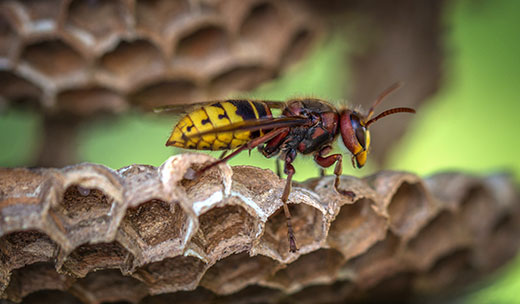
The yellow jacket wasp may look intimidating, but is actually beneficial in the home garden.
Yellow jacket buzzing? Leave it alone if you can, says horticulture expert
Common wasp may be more beneficial than harmful
Sept. 24, 2020
MANHATTAN, Kan. – Before you get tempted to take a swat at that yellow jacket wasp buzzing around the garden, think twice.
It’s probably doing you more good than harm.
Kansas State University horticulture expert Ward Upham said yellow jackets feed on soft-bodied insects, such as caterpillars and sawfly larvae that can be much more harmful than the yellow jacket to garden produce.
Further, the yellow jacket is more interested in areas where there is human or pet food, and compost piles, rather than flowers.
“If a nest of yellow jackets is found, it is best to avoid the area because the wasps are more aggressive near their nest,” Upham said. “The nest should not be destroyed unless it presents a danger to people.”
The yellow jacket wasp is about ¾ inch long with black and yellow coloring and long, dark wings. Because of that, it can often be confused with honey bees; however, bees tend to be more round in appearance.
“We have had reports of yellow jackets becoming more noticeable as they scavenge for food,” Upham said. “They are most active up to the time that the weather turns cold in the fall.”
Yellow jacket wasps will sting when threatened. Upham suggests avoiding areas where yellow jackets are nesting, as well as removing food sources near living areas. “This includes picking up and disposing of fruit that may have dropped from trees,” Upham said.
Time of year…
Yellow jacket wasps aren't the only thing on gardener's minds right now. Spring and summer vegetables have likely all been harvested, Upham said, but that doesn’t mean the work is done.
For example, October is a good time to plant garlic to increase the chances of producing large, quality cloves next summer. Those who hope to grow fruit next year should prepare the site this fall.
Many other time of year tips are available in the weekly Horticulture Newsletter, which is published by Upham and his colleagues in K-State’s Department of Horticulture and Natural Resources. The newsletter is available to view online or can be delivered by email each week.
Interested persons can also send their garden- and yard-related questions to Upham at wupham@ksu.edu, or contact your local K-State Research and Extension office.

